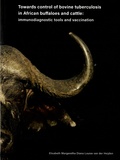Towards control of bovine tuberculosis in African buffaloes and cattle
Immunodiagnostic tools and vaccination
Summary
The overarching aim of the studies presented in this thesis was to contribute to the understanding of the role of diagnostic tools and vaccination in the control of bovine tuberculosis (BTB) in the two most important host species in South Africa, African buffaloes (Syncerus caffer) and domestic cattle (Bos taurus). Application and performance of well-known immunodiagnostic assays for detection of Mycobacterium bovis (M. bovis) infections in cattle were evaluated for use in African buffaloes (Chapter 2). The use of single application as well as parallel testing of the tuberculin skin test (TST), first and second generation BOVIGAM® assays (B1G and B2G) and the IDEXX M. bovis Ab test (TB ELISA) in the field was addressed, with the purpose of achieving high sensitivity (Se) (in line with the test purpose in the Hluhluwe-iMfolozi Park (HiP), aiming at a reduction in BTB prevalence). Single test application resulted in a positive responder frequency of 100% for the TST and a Se of the B1G and B2G of 100% and 75%, respectively, whereas the sensitivity of the TB ELISA was only 37.5%. Parallel test combinations yielded the highest Se and the inclusion of the B1G in such a testing strategy proved essential. The use of the TST and B1G in African buffaloes, however, has limitations in terms of practicality as well as well-being of the animals, given the need for repeated immobilisations. Serological assays may overcome these issues, provided test performance, Se and specificity (Sp), can be established similar to those of the TST-B1G combination. For that purpose, we established the BTB prevalence in an unbiased manner based on the TST as a reference (using estimated Se and Sp of the TST in buffaloes) in free-ranging populations of buffaloes in the HiP and the Madikwe Game Reserve (MGR) (Chapter 3) and applied it to estimate the test performance of the TB ELISA. Furthermore, the influence of the prevalence of BTB and exposure to non-tuberculous mycobacteria (NTM) on the test performance of the TB ELISA, applied once-off and longitudinally, was investigated. The BTB prevalence was found to be significantly higher in the MGR (28.4%) as compared to the HiP (13.5%) which was attributed to the fact that an effective control program has been in place in the HiP since 1999, whereas the first interventions in the MGR only took place in 2016. Highly variable test performance was shown however: Se ranged between 0% and 42.2%, while Sp varied between 71.9% and 98.4%. Notably, the BTB prevalence affected the Se and Sp of the TB ELISA as these variables were found to be significantly different in cohorts of low versus high BTB prevalence. Despite the high diversity of NTM species found in both parks in the study, influence on the TB ELISA performance could not be confirmed. The studies clearly showed that the use of the present serological assay as a stand-alone test cannot be recommended for the detection of M. bovis infections in buffaloes.
